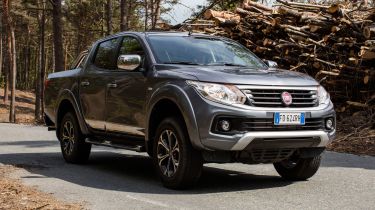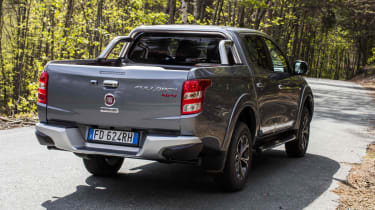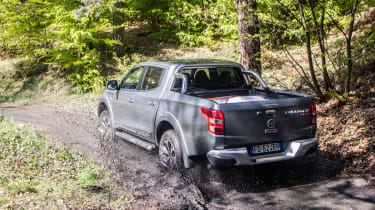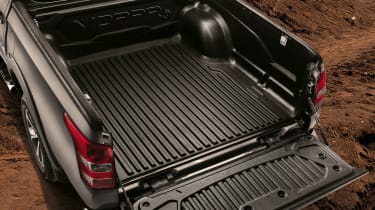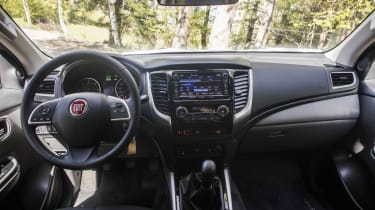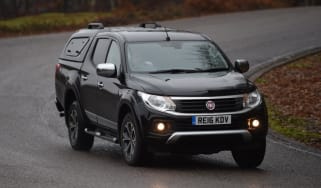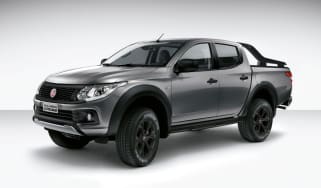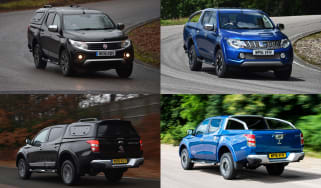Fiat Fullback pick-up review
The Fiat Fullback pick-up is a Mitsubishi L200 with a new face
Although the one-tonne, 4x4 pick-up market is booming globally, the big sales for trucks like the new Fiat Fullback are in the Southern Hemisphere. In Africa for example, over 60 per cent of light commercial vehicle sales are pick-ups, while in the UK it’s more like six per cent.
That hasn’t stopped a steady stream of new pick-ups piling in to British showrooms, largely thanks to a peculiarity in the UK tax regime. It means company car drivers can save thousands of pounds in tax by switching to a luxuriously equipped double cab pick-up. It also explains why 80 per cent of the pick-ups sold here are high-spec versions with leather upholstery, top-of-the-range touchscreen systems, big flashy alloy wheels and auto gearboxes – and not the utilitarian load-luggers the taxman probably had in mind when creating the concession.
The Fiat Fullback is one of the latest to arrive, and it doesn’t buck the trend for high equipment, lining up against rivals like the new Nissan Navara, updated Ford Ranger and VW Amarok, as well as the recently revamped Toyota Hilux and Mitsubishi L200.
Though the pick-up market is fresh territory for Fiat, the company has taken a very effective shortcut as – badges apart - the Fullback is an exact copy of the Mitsubishi L200, and built on the same production line.
Used - available now

2018 Mazda
6 Saloon
26,134 milesManualPetrol2.0L
Cash £14,063
2020 MINI
Countryman
31,160 milesAutomaticDiesel2.0L
Cash £16,587
2018 BMW
X5
48,752 milesAutomaticDiesel3.0L
Cash £24,606
2020 Volvo
XC60
53,700 milesAutomaticPetrol2.0L
Cash £20,406Unlike Mitsubishi, which offers regular and extended cab versions of the L200 to UK buyers, Fiat isn’t even bothering to offer a low-spec utility model of the Fullback over here. Its primary objective is to satisfy managers of Fiat-badged fleets who have company car drivers crying out for a tax-efficient pick-up option.
So the Fiat Fullback SX is the entry model, and it comes with a spec-list that’s very similar to the Mitsubishi L200 Titan. Standard kit includes a 148bhp version of the 2.4-litre diesel engine, DAB radio, cruise control, air-con, hill-hold and LED DRLs, but you only get a manual gearbox.
Picking the higher LX spec gives you more power with a 178bhp version of the same engine, plus the choice of six-speed manual or five-speed auto gears. You also get luxuries like electrically-adjusted and heated leather seats, privacy glass, dual-zone climate control, bi-xenon headlamps, a 6-inch touchscreen with sat-nav, lane departure warning and a softer suspension set-up that’s designed to add a little extra comfort. The £2k premium charged for an automatic LX also brings an upgraded 7-inch touchscreen and paddle gear shifters.
At the very top end of the range sits the Fullback Cross. This model gets all the same bells and whistles as the LX model, but it sports tougher looks and is more capable off road thanks to the addition of a fully locking rear differential.
MPG, CO2 and Running Costs
The Fiat Fullback shares its high-tech common-rail turbodiesel engine with the Mitsubishi L200, and like its sister-model comes with two power options – 148bhp or 178bhp. What that means, of course, is that the running costs of the Fullback and Mitsubishi will naturally be very similar.
The lower-powered variant manages a very competitive combined cycle fuel consumption figure of 44.2mpg, with CO2 emissions of 169g/km. The higher-powered 178bhp version manages 42.2mpg and 173g/km, which is almost as good, although we’d expect a bigger disparity in real-world economy if you use the extra power. Plump for the automatic model though, and as well as the £2k price premium you’ll face higher fuel bills. The official combined cycle figure dips to 39.2mpg, while emissions rise to 189g/km. The larger engine is the only option available under the bonnet of the Fullback Cross.
There’s no doubting the toughness of the Mitsubishi L200, so of course the Fiat version comes with the same benefits. We expect the requirement for extra-curricular repair and maintenance to be minimal, so even if you’re in warranty you’ll hopefully minimise vehicle ‘down-time’.
Service intervals are unremarkable at 12,500 miles or 12 months, but the Fiat does give away an advantage to the Mitsubishi on the warranty front, as the latter comes with up to five years cover. However while the Fiat is only in warranty for three years, you can drive it for up to 120,000 miles. The Mitsubishi’s warranty is capped at 62,500 miles.
Load Space and Practicality
The Fullback may be a little smaller than a number of its competitors, but it doesn’t give away anything in terms of practicality. Overall measurements of 5,285mm x 1,815mm mean it’s 13cms narrower than the VW Amarok, but with a load bed that’s 1,400mm square it will swallow a Euro pallet comfortably. The depth of the load bed is 475mm, and there are plenty of lashing points in the interior of the load area.
The Fiat’s maximum payload capacity is the same as the L200's, meaning all models have at least the critical 1045kgs rating required by the HMRC if you want a hardtop and a tax break. The HMRC stipulates a standard agreed weight of 45kgs for such items, even though many weigh a lot more. As such, any hardtop-equipped Fullback does still meet the one-tonne carrying capacity required by HMRC to make it eligible for commercial vehicle company vehicle tax rates.
The two rivals share the same towing capacity too, so you’ll be able to pull a braked trailer weighing up to 3,100kgs. This is down on the latest Nissan Navara, which can tow up to 3,500kgs.
Finally, it’s worth mentioning that the Fiat and Mitsubishi share the smallest turning circle in the class at just under 12m. If you have to maneouvre in tight sites or off-road, that could be significant.
Reliability and Safety
The latest Mitsubishi L200 made some pretty big advances on the safety front when it was introduced in 2015, and naturally they’re carried across to this rebadged Fiat version. Indeed, compared to the previous generation L200 the newcomer features greater chassis reinforcement and more inherent strength, before you even start to look at the new technology features that have been introduced.
The standard safety kit on the Fullback isn’t exactly groundbreaking, as things are moving fast in the commercial vehicle sector. Still, the features on offer will be very reassuring to drivers potentially moving to the sector from their company cars. There’s an advanced traction and stability control system that also includes Trailer Stability Assist, Hill Start Assist, hazard lights that operate automatically under heavy braking, and even Lane Departure Warning as standard on the LX model. You also get seven airbags, but unfortunately there’s no Hill Descent Control. This is one the most reassuring items on the spec sheet of rivals like the Nissan Navara or VW Amarok when driving seriously off-road, especially when loaded up, and is a surprising omission.
Driving and Performance
Since the new 2.4-litre four-cylinder engine debuted in the L200 in 2015, it’s been joined in a resurgent pick-up sector by the Nissan Navara with its equally advanced new 2.3-litre unit, and also faces competition from the latest 3.0 V6-powered VW Amarok. So while the Fullback is smooth and refined on the road, with plenty of power and torque from both 148bhp and 178bhp versions, the engine in the Fiat isn’t really able to open up much in the way clear water between itself and rivals from the driving perspective. It idles quietly, and you can hardly hear the engine at motorway cruising speeds, although there is some road noise.
In manual guise the Fiat/Mitsubishi duo are a little more pleasant to operate than the Navara thanks to a smooth and unobstructive shift quality. But the Navara and the Amarok have the edge in automatic guise where their 7- and 8-speed gearboxes have a more seamless feel than the five-speed auto in the Fullback/L200.
The fastest Navara will hit 0-62mph in 10.8 seconds, and while official figures have not yet been released for the Fullback we’d be surprised if they differ much on the road. Drivers will probably find that level of performance acceptable, unless they’ve sampled the 7.9 second acceleration time of the most expensive 221bhp VW Amarok of course…
Like the L200, the Fullback comes with two different drive systems. The SX – which is manual only – has a three-position switch to control high ratio 2wd, and low- and high-ratio 4wd. The LX comes with the Super Select 4x4 system originally developed for the Mitsubishi Shogun SUV. It means you have the option of two- or four-wheel-drive on tarmac, plus the option to lock the centre differential to improve traction. The same Super Select system on the Fullback Cross features a locking rear differential too, so it's the one to think about if you'll be doing serious off-roading.
As soon as you’re away from glass-smooth tarmac the limitations of the Fullback’s live rear axle make themselves known via a bouncy, noisy ride. It’s not as bad as some of the cruder pick-ups, but the Navara has notably better ride refinement thanks to its more complicated rear suspension. The Fiat has the better-weighted steering, and retains a decent amount of composure in cornering too, although it’s still some way off modern SUV standards from a driver’s perspective.
Cab and Interior
There’s a roomy feel to the Fullback’s cab, but like its Mitsubishi sister car there’s a slightly dated feel to some of the fixtures and fittings. And while the pick-up is well equipped, both the Navara and Amarok beat it for that all-important premium ambience.
There’s lots of adjustment available for drivers of all sizes, and the double cab provides plenty of space for adults in the second row. Access is good too, thanks to the rear doors, but as is common in the pick-up sector low seats mean rear passengers sit with their knees up.
The Fullback doesn’t feature any particularly notable cabin storage solutions either, but there’s a storage compartment between the front seats, narrow door bins and a small-ish glovebox.

